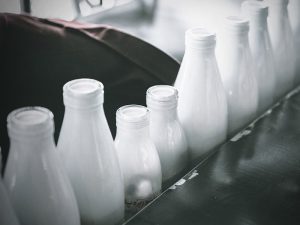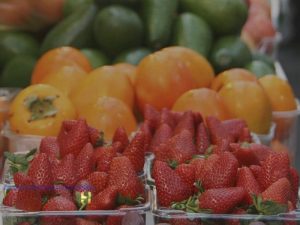In order to make healthy food choices, you should first understand the common components of what makes up your food. One is trans-fat, a fatty acid some health specialists tell you to avoid. There are two main groups of trans fats: naturally-occurring and artificial.
- Naturally-occurring: This type of trans fat is a natural product, as the name suggests, that is produced in the gut of some animals and found in products created from them.
- Artificial: Made through an industrial process, in which hydrogen is mixed with liquid vegetable oils to make a solid trans fat product, this is the type of trans fat you have been told to stay away from.
Eating large quantities of foods containing artificial trans fats can put you at a higher risk of developing heart diseases, stroke and type 2 diabetes. So why, despite the health risks, do food companies and restaurants still choose to use trans fats? Cooking with trans fat is easy and inexpensive. Trans fats are also used in the making of some of our favorite junk food items and to give them their desired taste. You don’t have to cut out trans fat altogether, but there are recommended amounts and facts that can help you make informed decisions about your diet. If you suffer from heart or cholesterol conditions your doctor may suggest eliminating trans fat completely. Trans fat can raise your bad cholesterol levels, so keep everything in moderation.
What Foods Contain Trans Fat?
The first step to regulating trans fat intake is to know what foods contain the fatty acid.
A good tip to remember when shopping is some labels disguise trans fats as “partially hydrogenated oils”: Common foods containing artificial trans fat, that you should avoid or cut down on include:
- Cakes, pies and cookies.
- Biscuits.
- Breakfast sandwiches.
- Margarine.
- Crackers.
- Microwave popcorn.
- Doughnuts.
- Fried fast food.
- Frozen pizza.
- Coffee creamer.
Naturally-occurring trans fats are preferable to artificial, and there is no substantial proof that naturally-occurring trans fats have the same negative effects on cholesterol as artificial trans fats. The following animal products naturally contain trans fats:
- Beef.
- Lamb.
- Dairy products.
One of the keys to healthy eating is knowing what is in your food, so get into the habit of reading shopping labels.
Saturated Fats v Trans Fats v Unsaturated Fats
If you have heard about trans fats, you may have heard about saturated fats. Saturated fats are defined by their chemical make-up; they have double bonds between carbon molecules because they are saturated with hydrogen molecules. They are referred to as a “solid” fats and also occur naturally in animal products such as:
- Fatty beef.
- Lamb.
- Pork.
- Poultry with skin.
- Beef fat.
- Lard and cream.
- Butter.
- Cheese.
- Milk fat.
Along with trans fats, saturated fats are found in many baked goods and fried foods, causing a spike in bad cholesterol. Saturated fats have a healthier sibling, known as unsaturated fats. Unlike the “solid” make-up of saturated fats, unsaturated fats have a looser chemical bond that makes them more fluid. These occur naturally in plant sources such as:
How Much Trans Fat is Recommended?
The rule for consumption of trans fats is moderation. The American Heart Association recommends decreasing the intake of saturated and trans fat and replacing them with better fats. Taking this step can impact heart health. Guidelines recommend lowering saturated and trans fat intake to no more than 5 per cent to 6 per cent of your total calories. If your average calorie intake is 2000 calories a day, that is about 13 grams of saturated fat. If you suffer from high cholesterol or a heart condition, talk to your doctor about an appropriate saturated and trans fat intake.
Healthy Fats
At this point you may be thinking that fat is only a negative word, but there are healthy fats that are necessary for overall wellness. Monounsaturated fats and polyunsaturated fats help balance the good cholesterol in the body and decrease your risk of heart disease.
- Monounsaturated fats: Found in avocados, almonds, cashews, peanuts, natural cooking oils (canola, peanut).
- Polyunsaturated fats: Found in fish, tahini, linseed, pine nuts, soybeans, chia seeds, flaxseed.
- Omega-3: This subgroup of polyunsaturated fat has several health benefits, such as lowering heart rate, decreasing the risk of blood clotting, reducing blood pressure and improving blood vessel function.
Changing your diet can feel like an overwhelming task but with research and planning it is possible. Tips for making healthy changes to your diet include:
- When grocery shopping/meal planning emphasize fruits, vegetables, whole grains, low-fat dairy products, poultry, fish and nuts.
- Avoid fried food, processed foods, sugary foods and beverages.
- When buying processed foods look for items made with unhydrogenated oils.
- Use soft margarine, made with no hydrogenated oils, instead of butter.
- Cook with natural, unhydrogenated oils such as canola, safflower, sunflower or olive oil.
- Drink fat-free or low-fat milk instead of reduced-fat milk.
- Buy lean-fat
- Replace sour cream with plain, low-fat yogurt.
- Replace meat with fish for meals two or three times a week.
- Replace processed snacks high in trans fats with unsalted nuts high in monounsaturated fats.
It can be hard to give up guilty-pleasure foods that are high in trans fats or saturated fats. Look for homemade recipes and alternatives. Is your guilty-pleasure food frozen pizza? Spend a few minutes on the internet and then give making homemade pizza with your own healthy, personalized ingredients a try. Your heart will thank you!











